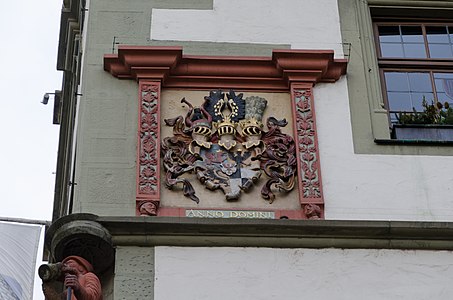Town Hall (Kitzingen)
The historic town hall Kitzingen is located on the market square in the old town of Kitzingen in the district of the same name in Bavaria . It is registered as a protected architectural monument.
The town hall was built from 1561 to 1563 by Master Eckhart von Schaffhausen in the Renaissance style and is one of the most important architectural monuments from this era in Lower Franconia . The three-storey building, which dominates the Kitzingen market square with its gable front and the steep, slate-covered gable roof , still serves the purpose for which it was built.
history
Due to the fact that the town of Kitzingen belonged to the Benedictine monastery , the citizens of Kitzingen were not allowed to build their own town hall for a long time in the Middle Ages . The beginnings of today's building lay in a department store and trading house on the market square, which served purely commercial and not yet administrative purposes. A few things are known about its structural design. It must have been a half-timbered building with an open market hall on the ground floor , the structural design roughly comparable to the still existing town hall in Michelstadt in the Odenwald .
It was only with the decline of the monastery during the Reformation and the simultaneously growing bourgeoisie at the beginning of the early modern period that the necessary prerequisites for the construction of a town hall were created, in which the town council could meet.
On New Year's Eve 1984/85, the town hall narrowly escaped destruction when a misdirected fireworks rocket set off a roof truss fire. However, thanks to the rapid intervention of the Kitzingen fire brigade, the fire could be contained to such an extent that no major damage was caused to the interior. However, the roof with its delicate dormers had to be completely renewed.
description
The town hall has a slightly trapezoidal floor plan, which means that the narrow side in the north is wider than that in the south. It has three storeys and has powerful curved gables on both narrow sides with six half and one full round elements at the top. Typical of the German Renaissance are the large windows on all sides, which provide enough light. On the south side - facing the market square - there is a round-arched gate with the Kitzingen coat of arms in the keystone and the year construction began in 1561. On the left is the richly decorated main portal, behind which a wide staircase leads to the first floor. The portal is covered by a flat triangular gable and contains the following inscription in the cornice: “Anno Domini 1561, the mayor and Rhath alhie had this Rhathauß from newem bawen - God alone the honor through Christ. Amen."
On the southeast side, at the level of the first floor, an artistically designed inscription panel in Latin provides information about the background of the new town hall and its function. Above, at the level of the second floor, is the coat of arms of the Margraves of Brandenburg-Ansbach , who were the city lords at the time the town hall was built. The reddish sandstone figure on the southeast corner just below the cornice between the first and second floor represents the so-called Kitzinger Häcker. It is a winemaker with a vineyard hoe who drinks wine from a jug and thus points out the importance of viticulture for the city and region. At the height of the market square, the Kitzinger Elle hangs as a guide and length measure. On the north side of the town hall on today's Kaiserstraße there is a stair tower with a half-conical roof. Next to it on the facade is the counterpart to the Häcker, the so-called Kitzinger Kätherle, a female figure with a bare bottom and a wine jug in her hand.
Behind the entrance gate extends the town hall hall with groin vaults that rest on six massive octagonal pillars. It refers to the town hall's original importance as a trading house.
A jewel among the rooms in the interior of the town hall is the wood-paneled council room on the second floor with a square-paneled wooden ceiling and pilasters on the walls. The city magistrate used to meet there. It can be entered through a magnificently designed, but from today's perspective, somewhat low door with side pillars. The council chamber is used today for representative occasions and as a registry office.
particularities
The World Press Photo exhibition has been held every spring since 2007 in the Kitzinger Rathaushalle . It attracts up to 20,000 visitors to Kitzingen every year, which roughly corresponds to the population of the small town. The award-winning press photos from the previous year will be shown, a total of 180 large-format images from over 73,000 entries by 4,500 photographers. Otherwise, the traveling exhibition only stops in larger metropolises like Amsterdam.
See also
literature
- Helga Walter (Ed.): The town hall of Kitzingen - built 1561-1563. Symbol of the self-confident bourgeoisie (= writings of the Kitzingen City Archives, Volume 3), Kitzingen, 2nd revised edition 2013.
- Hans Bauer: District of Kitzingen. An art and culture guide . Market wide 1993.
Web links
Individual evidence
- ↑ List of monuments city of Kitzingen. Bavarian State Office for Monument Preservation, November 16, 2017, accessed on November 19, 2017 .
- ↑ a b c d Hans Bauer: District of Kitzingen. An art and culture guide . Color printing Brühl, Marktbreit, p. 48 .
- ↑ Frank Weichhan: World Press Photo: 000. On the way to 250 visitors. In: inFranken.de. The Kitzinger, February 21, 2019, accessed on February 21, 2019 .
Coordinates: 49 ° 44 ′ 20.5 " N , 10 ° 9 ′ 41.3" E



